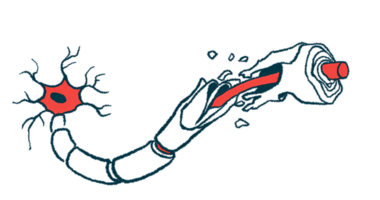AAN 2025: Combined first Briumvi dose well tolerated in relapsing MS
In ENHANCE study, a single 600 mg dose replaced approved 150/450 mg dose

A single 600 mg dose of Briumvi (ublituximab-xiiy) — instead of the approved 150 mg initial dose plus a 450 mg dose two weeks later — was well tolerated by adults with relapsing forms of multiple sclerosis (MS).
That’s according to new data from the ENHANCE Phase 3b clinical trial (NCT05877963), which is evaluating the safety and efficacy of a modified treatment regimen of Briumvi.
“We are encouraged by the results from the ENHANCE trial presented yesterday, which demonstrated that a single, day one 600 mg dose of Briumvi was well tolerated,” Michael S. Weiss, CEO and chairman of TG Therapeutics, said in a company press release.
John F. Foley, MD, a neurologist and researcher at Rocky Mountain Multiple Sclerosis in Utah, presented the data at the American Academy of Neurology 2025 Annual Meeting this month in San Diego. Foley’s poster was titled “Safety and Tolerability of a Modified Dosing Regimen of Ublituximab: Updates from the ENHANCE Study.” TG Therapeutics funded the work.
Briumvi is an antibody-based therapy approved for adults with relapsing forms of MS, which include clinically isolated syndrome, relapsing-remitting MS (RRMS), and active secondary progressive MS (SPMS). It targets the CD20 receptor at the surface of immune B-cells, which are thought to contribute to the inflammation that drives MS, causing their depletion. Briumvi’s mechanism of action is similar to other approved CD20 inhibitors, including Ocrevus (ocrelizumab), Kesimpta (ofatumumab), and rituximab, which has been used off-label in MS.
Administered intravenously, the first dose of Briumvi contains 150 mg, given over four hours, with a second 450 mg dose given over an hour two weeks later. All subsequent doses are given as hourlong 450 mg infusions every six months. In comparison, Kesimpta is given monthly via an injection under the skin, or subcutaneously, after three weekly injections, while the others are typically given intravenously every six months.
ENHANCE is an open-label trial that’s evaluating optimized dosing regimens for Briumvi. It plans to enroll up to 300 adults, ages 18-65, with relapsing forms of MS, who are either new to treatment or transitioning from other disease-modifying therapies (DMTs). Recruitment is ongoing at multiple sites in the U.S.
An interim analysis of 34 patients previously treated with Ocrevus showed that switching to a 450 mg Briumvi dose — thus bypassing the 150 mg initial dose — was safe and more effective at depleting B-cells than Ocrevus.
Combining two doses of Briumvi
The new data focused on the safety of combining the first two doses of Briumvi (150 mg and 450 mg) into one initial 600 mg dose in patients who were either treatment-naïve or previously treated with DMTs. The goal was to provide data to support the launch of a registrational trial to gain regulatory approval for the new regimen.
“We are excited to further evaluate this approach, with the aim of initiating a registration-directed trial to combine the currently approved day 1 and day 15 doses of Briumvi into a single 600 mg dose on day 1 and ultimately incorporate this regimen into the Briumvi label,” Weiss said.
Of the 103 MS patients evaluated in ENHANCE so far (69% women), 70 were considered non-depleted because they had at least 10 B-cells per microliter (mcl) of blood. Among them, about 1 in 5 (21%) had previously received Ocrevus, about 1 in 4 (27%) were treatment-naïve, and the remainder were given other DMTs. These patients were treated with a 600 mg dose of Briumvi over three to four hours on day one and a second 450 mg dose over 30 minutes at 24 weeks, or about six months.
Thirty-three participants were deemed depleted as they had less than 10 B-cells/mcl. Most were previously treated with Ocrevus (85%) and the rest with Kesimpta (15%). This group received 600 mg of Briumvi over an hour, with the same second dose regimen as the non-depleted group.
Before each infusion, the patients received antihistamines to prevent allergic reactions, antipyretics to reduce fever, and intravenous corticosteroids to lower the risk of infusion-related reaction (IRR), or an adverse reaction during the infusion. Nearly all (88%) the infusions were completed without interruption or slowing. The primary outcome was the proportion of patients in each group who had an IRR.
In the non-depleted group, 24.3% reported an IRR. Of these, 12.9% were mild (grade 1), 10% were moderate (grade 2), and 1.4% were considered severe (grade 3). Likewise, 27.3% of the depleted group reported an IRR, of which 21.2% were grade 1 and 6.1% were grade 2.
IRR symptoms reported in more than two patients were headache (5.8%), shortness of breath (3.9%), nausea (3.9%), throat irritation(3.9%), chills (2.9%), muscle pain (2.9%), and itching (2.9%). All were completely resolved.
“Data from ENHANCE supports that combining the initial day 1 (150 mg) and day 15 (450 mg) infusions into a single 600 mg dose is well tolerated in all participants regardless of B-cell depletion status,” the researchers wrote.
“Our goal remains to strive to develop and enhance treatment options for individuals with MS,” Weiss said.







